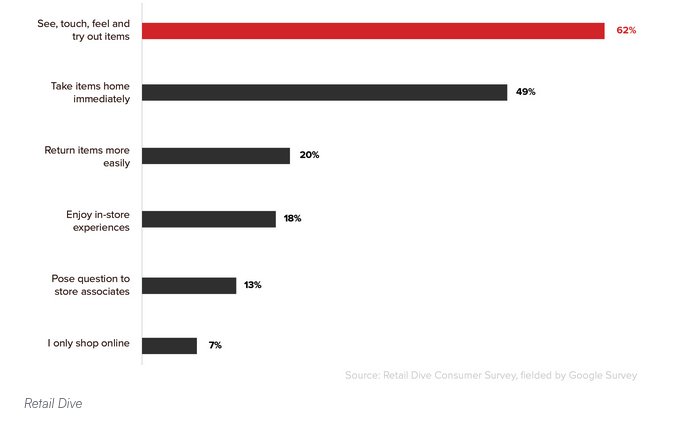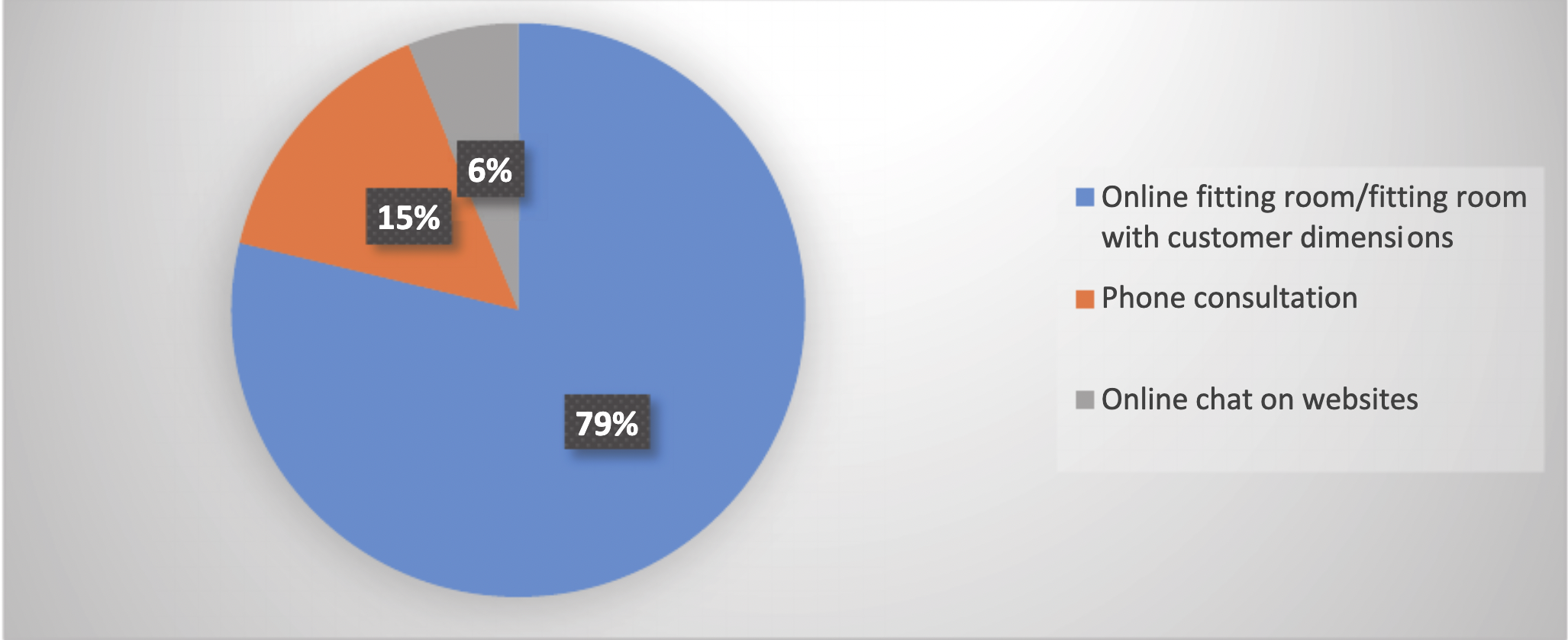Table of Contents
- Key Takeaways
- The Rise of Virtual Fitting Rooms in Ecommerce
- Enhancing CX Through Virtual Fitting Rooms
- The Business Impact: Driving Ecommerce Success
- Case Studies: Successful Implementation of Virtual Fitting Rooms
- Considerations for Implementing Virtual Fitting Rooms
- Trends in Virtual Fitting Room Technology
- Bottom Line
Shopping online is more than just convenient – it’s the new normal. But as ecommerce grows, so do customer expectations. Today’s shoppers aren’t just looking for products; they’re looking for experiences. A seamless, personalized, and engaging buyer journey is the difference between a one-time shopper and a loyal customer. This is why Customer Experience has become the heart of online retail success.
One of the most innovative ways brands are leveling up their CX is through Virtual Fitting Rooms (VFRs). By blending cutting-edge technology with customer needs, VFRs are solving a long-standing problem in ecommerce: How do you help shoppers feel confident in their purchase without a physical try-on?
In this article, we’ll explore how Virtual Fitting Rooms benefit customers and brands, from boosting customer confidence and reducing returns to increasing sales and loyalty. We’ll also look at the technology driving VFRs, examples of success stories, and why now is the time for ecommerce brands to embrace this game-changing solution.
Let’s dive in!
Key Takeaways
- VFRs bridge the gap between online and in-store shopping by allowing customers to virtually try on products, providing a personalized and engaging experience that builds trust and confidence.
- By addressing common issues like sizing uncertainty and buyer hesitation, virtual fitting rooms help eliminate the friction customers face when shopping online, resulting in more satisfied and loyal shoppers.
- Retailers using VFR technology report significant benefits, including an increase in average order value, higher conversion rates, and reduced return rates.
- While challenges like cost and data privacy exist, the long-term benefits far outweigh these hurdles, with more and more third-party providers offering affordable solutions to make the technology accessible even for small and mid-sized retailers.
- VFRs create a consistent and efficient omnichannel shopping experience across both online and in-store environments.
The Rise of Virtual Fitting Rooms in Ecommerce
Virtual fitting rooms are taking the ecommerce world by storm. What once seemed like futuristic tech is now becoming a must-have for online retailers looking to stand out and provide a top-notch customer experience. But why are VFRs growing so quickly? Let’s break it down.
Market Growth and Adoption Rates
The virtual fitting room market is booming – and the numbers speak for themselves. In 2024, this market is expected to be worth $5.71 billion, but that’s just the beginning. By 2032, it’s projected to skyrocket to $25.11 billion, growing at an impressive compound annual growth rate (CAGR) of 20.3%.
This growth isn’t surprising when you consider the increasing demand for better online shopping experiences. Customers want more than static images and size charts – they want to see how products will look and fit before they buy. For retailers, this presents an opportunity to not only attract new customers but also keep existing ones coming back for more.
This growth is also fueled by retailers who recognize the power of VFRs to attract and retain buyers. With brands like Walmart, ASOS, and H&M leading the way, virtual fitting rooms are quickly moving from “nice-to-have” to “must-have” for ecommerce platforms.
What’s driving this growth?
- A shift in shopping habits, with more people relying on online stores. The global ecommerce market is projected to reach $6.09 trillion in 2024, marking an 8.4% increase from the previous year.
- Retailers looking to reduce returns, which cost the ecommerce industry billions every year. In 2022, retail returns in the United States amounted to $817 billion, with a quarter of this figure originating from online retailing.
- The rise of technologies like augmented reality (AR) and artificial intelligence (AI), making VFRs more accurate and accessible than ever.
Technological Advancements Driving Adoption
So, what’s making all of this possible? Virtual fitting rooms rely on a combination of cutting-edge technologies. Just a few years ago, this kind of innovation seemed out of reach for most retailers. Now, it’s becoming mainstream, thanks to advancements in AR and AI.
Here’s a closer look at some of the key technological advancements fueling VFR adoption:
- Augmented Reality (AR): AR allows shoppers to see products “on” themselves by overlaying digital images onto live video feeds. This technology has become more advanced, offering better image quality and accuracy, so customers can visualize how an item will look and fit in real-time. It’s like having a dressing room anywhere, anytime.
- Artificial Intelligence (AI): AI takes things to the next level by learning and adapting to each user. It can recommend sizes based on past purchases, analyze body dimensions, and even suggest complementary items to create a full outfit. This personalized experience makes online shopping feel a lot more like in-store shopping.
- 3D Scanning and Modeling: Some VFRs are now using 3D body-scanning technology, allowing customers to create avatars or accurate digital replicas of themselves. This enables even more precise fitting simulations and helps customers feel more confident about sizing, which is a common hurdle in online shopping.
- Mobile Integration: The rapid advancement in smartphone technology has made it easier for customers to access VFRs from their mobile devices. Retailers are now integrating VFRs directly into their apps, allowing customers to “try on” items with just a tap, right from their phones. Data shows that mobile shopping now accounts for 60% of global ecommerce sales, making mobile compatibility a must-have for VFR success.
These technologies aren’t just for the tech-savvy crowd. They’re designed to be intuitive and easy to use, ensuring that even less tech-inclined shoppers can enjoy the benefits of virtual try-ons.
Why now?
- Increased smartphone and internet accessibility means more people can interact with VFRs.
- Retailers are investing in user-friendly interfaces to make the experience seamless.
- As the cost of implementing AR and AI decreases, even small to mid-sized businesses can afford to adopt this technology.
Next up, we’ll outline the key benefits of virtual fitting rooms and how they’re transforming the online shopping experience.
Enhancing CX Through Virtual Fitting Rooms
Virtual fitting rooms add a level of personalization and interactivity that was once only possible in physical stores. By letting customers “try on” products virtually, VFRs help online retailers create memorable, engaging experiences that go far beyond scrolling through product photos. Here’s how VFRs enhance customer experience and build trust:
1. Personalization and Engagement
One of the biggest challenges in ecommerce is making customers feel seen and valued. Unlike physical stores, where a salesperson can provide personalized advice, online shopping often feels impersonal. VFRs are changing that by offering a level of personalization that makes customers feel like the experience is tailored just for them. This goes a long way in ecommerce, where personalization can make all the difference in whether a customer completes a purchase or clicks away. Here’s how:
- Real-Time Virtual Try-Ons: VFRs let customers see how clothes, accessories, or even makeup products look on them in real-time. It’s not a one-size-fits-all approach; it’s all about you. Whether it’s choosing the perfect dress for a special event or the right pair of sunglasses, VFRs help customers visualize how they’ll look before they click “buy”.
- Interactive Features: Many VFRs include options for customizing styles, colors, or sizes, creating an engaging experience that feels more like play than shopping. This added layer of interactivity doesn’t just keep customers on the site longer – it keeps them coming back.
- Tailored Recommendations: Powered by advanced AR and AI, virtual fitting rooms adapt to each shopper’s unique profile in real-time. By analyzing a customer’s body shape, style preferences, and product interactions, brands can suggest clothing that not only fits well but also aligns with individual preferences. These recommendations go beyond standard sizing – they consider fabric, cut and drape, creating a shopping experience that feels thoughtful.
Why it Matters: According to McKinsey, 71% of consumers expect personalized experiences, and 76% feel frustrated when brands don’t deliver. What’s more, studies show that personalization in ecommerce can boost customer satisfaction by up to 20% and can increase conversion rates by as much as 10%, creating deeper connections between customers and brands.
2. Confidence in Fit and Style
Another pain point in online shopping is uncertainty – “Will it fit? Will it look good on me?”. VFRs tackle this head-on by giving customers a realistic preview of how products will fit and look.
- Accurate Fit Previews: VFRs simulate the exact fit of clothing or accessories, allowing customers to feel more confident in their choices. This reduces the frustration of receiving an item that doesn’t meet expectations.
- Eliminating Guesswork: Say goodbye to endless size charts or trying to measure yourself with a tape measure. VFRs use AI to recommend the right size based on body dimensions or past purchases, making the process seamless.
Result: By removing the uncertainty of online shopping, they help customers feel good about their choices. And when customers feel good, they’re more likely to buy, return, and spread the word about your brand. It’s a win-win for everyone! Research shows that more than 90% of Americans are open to using augmented reality in shopping, with 98% of those who have tried AR finding it helpful, showcasing its value in building trust and satisfaction.
3. Connected Shopping Experience Across Channels
VFRs enable a connected shopping journey that blends the best of digital and in-store experiences. A major hurdle for online fashion retailers has always been replicating the physical experience of seeing, touching, and trying on products – one of the key reasons 62% of shoppers still prefer in-store buys. This sensory aspect of shopping has long been a limitation for ecommerce, but virtual fitting rooms are changing the game.

Leveraging AR technology, virtual fitting rooms allow customers to try clothing digitally, creating a more engaging and realistic shopping experience. According to the Retail Perceptions Report, 40% of consumers would even pay more for products they could experience through augmented reality, showing the high demand for immersive shopping options.
Virtual fitting rooms also enhance the omnichannel shopping journey, allowing brands to offer a seamless experience across digital and physical platforms. For example, customers can try on items virtually at home, save their selections, and later see those exact items in-store. This smooth transition between channels not only makes shopping more convenient but also keeps each touchpoint personalized, as virtual fitting room data can inform in-store recommendations.
Why It’s Game-Changing: By bridging online and offline channels, VFRs create a consistent and cohesive experience that fosters loyalty. Shoppers who feel supported across platforms are more likely to engage with a brand repeatedly.
4. Social Sharing and Community Engagement
Virtual fitting rooms make shopping more interactive by enabling customers to instantly share their virtual try-ons with friends on social media. This feature adds an element of fun, turning a solo shopping experience into a social one where friends can offer feedback, react, and get inspired.
When customers post their try-ons on platforms like Instagram or TikTok, they organically spread the word, giving brands valuable exposure to a wider audience. Each shared post sparks curiosity, generates buzz, and enhances brand visibility. This helps build a sense of community and excitement around products, making the shopping experience more dynamic and engaging for everyone involved.
Impact: Social sharing turns individual shopping experiences into community-driven ones, enhancing engagement and giving brands free exposure.
5. Accessibility and Convenience
VFRs remove barriers that traditionally hinder online shopping, making it easier for diverse audiences to enjoy an interactive experience.
- Effortless and Time-Saving: Virtual fitting rooms allow customers to try on multiple items quickly without the need to visit a physical store or deal with the hassle of changing rooms. This convenience is particularly appealing to busy shoppers who value efficiency.
- Streamlined Shopping: Instead of toggling between size charts and product images, shoppers can get instant feedback on fit and style, speeding up the decision-making process. This creates a more efficient path to purchase while minimizing inquiries about sizing and fit, reducing the burden on customer support.
- Accessible to All: Customers in remote areas or those with mobility challenges can experience the benefits of trying on items virtually. By providing an inclusive shopping experience, retailers can reach a broader audience and cater to diverse customer needs.
Takeaway: Convenience matters! According to a survey by PwC, 51% of consumers rank it as a top factor in their purchasing decisions. VFRs deliver this by streamlining the buyer journey, reducing effort, and increasing satisfaction.
6. Invaluable Customer Data
Virtual fitting rooms also offer a treasure trove of insights into customer preferences and behaviors. By tracking which items customers try on virtually, brands can gain a better understanding of popular styles, colors, and fits. This data can inform everything from inventory decisions to targeted marketing campaigns, allowing brands to personalize their offerings even more. For instance, if data shows a high virtual try-on rate for a particular style, the brand might feature it more prominently or even create similar items based on that interest.
Why It Matters: This customer feedback loop improves the shopping experience while helping brands fine-tune their product lines to better meet customer demand.
7. Brand Loyalty
Positive shopping experiences are key to building brand loyalty. When customers enjoy a seamless, interactive, and personalized shopping experience, they’re more likely to return to that brand for future purchases. Virtual fitting rooms create memorable, engaging experiences that stand out from the usual “add to cart” routine, encouraging repeat business.
Result: More loyal customers associate the brand with innovation, convenience, and reliability.
In the next sections, we’ll dive into how these benefits translate into measurable gains for ecommerce businesses and look at success stories from brands that have embraced VFR technology.
The Business Impact: Driving Ecommerce Success
Virtual fitting rooms don’t just enhance the shopping experience, they drive real, measurable results for retailers. By addressing the most critical challenges in ecommerce, VFRs deliver a powerful return on investment. Here’s how:
Increased Conversion Rates
One of the most impressive outcomes of virtual fitting rooms is their ability to boost conversion rates. When customers can see exactly how a product will look or fit, they’re more likely to make a purchase. It’s simple: confidence leads to commitment. To put it in numbers, Shopify studies show impressive results: brands like Rebecca Minkoff found that shoppers who used 3D views were 44% more likely to add items to their cart and 65% more likely to buy after trying augmented reality. It’s clear that immersive tools can turn browsers into buyers. Moreover:
- Boosting Average Order Value: Customers who use VFRs are not only more likely to buy but often add more to their carts. Retailers implementing VFR technology have seen average order values increase by up to 20%. The added confidence in size and fit means shoppers are more willing to try new styles or purchase additional items, knowing they’re likely to be satisfied with their choices.
- Higher Engagement = Higher Conversions: VFRs make shopping more interactive and enjoyable, which means customers spend more time on the site and explore more products. This extended engagement naturally leads to more conversions, as customers feel more assured of their selections.
Takeaway: When buyers are confident in how a product will look and fit, they’re far more likely to hit “Add to Cart”. And when this experience feels personal and engaging, they’re also likely to spend more, boosting overall sales.
Reduction in Product Returns and Associated Costs
Returns can be costly for retailers, both financially and environmentally, so reducing return rates is a top priority. Looking into the industry-specific return rates, according to Shopify, clothing had the highest return rate at 25%, followed by bags, accessories, and shoes at 18%, making VFRs especially impactful.
- Fewer Fit-Related Returns: The average ecommerce return rate reached 18% in 2023 for online purchased merchandise, with 65% of online shoppers returning items because they didn’t fit. Virtual fitting rooms address this issue by helping customers select the right size and style from the start, significantly reducing the guesswork. In fact, studies show that companies using virtual fitting technology have decreased return rates by up to 36%, resulting in substantial savings on logistics, restocking, and processing costs. At the same time, Shopify saw as much as a 40% decrease in returns in 2020 by using augmented reality (AR) visualization.
- Cost and Environmental Savings: Reducing returns not only saves money in terms of shipping and handling but also reduces the environmental impact associated with reverse logistics. Less packaging waste, fewer carbon emissions from shipping, and reduced waste from discarded products make VFRs an eco-friendly solution.
Takeaway: By reducing returns, VFRs create a win-win for customers and retailers alike. Customers are happier with their purchases, and brands save on the significant costs associated with processing returns. It’s a powerful tool for driving profitability and sustainability in online retail.
Why This Matters
For retailers, the financial and reputational benefits of VFRs are significant. Increased sales and reduced returns translate directly into higher profits and improved operational efficiency. At the same time, customers enjoy a better shopping experience, leading to stronger loyalty and repeat business. It’s a win-win scenario that shows how innovative technology can drive both customer satisfaction and business success.
Case Studies: Successful Implementation of Virtual Fitting Rooms
In a recent survey, 79% of shoppers identified virtual fitting rooms as the most effective way to improve online shopping and reduce returns. This technology clearly meets the growing demand for enhanced online shopping experiences, making sizing more accurate and building trust between shoppers and brands.

Several major retailers have already experienced these impressive results from integrating virtual fitting rooms into their ecommerce experience. Let’s look at some standout examples to highlight how VFRs can drive engagement, increase conversions, and provide a more personalized shopping experience.
Walmart’s Integration of Zeekit Technology
In May 2021, Walmart took a bold step to improve its online shopping experience by acquiring Zeekit, a virtual try-on company. Zeekit’s technology allows Walmart shoppers to visualize how clothing items would look on a digital version of themselves, using advanced image processing and AI originally developed for topographic mapping.
- How It Works: Zeekit allows shoppers to upload their photos or choose a model that matches their body type. Unlike simpler solutions that overlay static images of clothing, Zeekit offers an ultra-realistic simulation, showing how garments drape, where shadows fall, and how the fabric moves. For example, a single shirt available in four colors, five sizes, and two sleeve lengths can be visualized uniquely for each user, showcasing the full range of options and how they fit.
- Why It Matters: With Walmart’s vast inventory, the addition of VFR technology helps customers navigate sizing challenges and make more confident purchasing decisions. It’s especially valuable for Walmart’s private-label clothing brands, where customer engagement and satisfaction are key to driving loyalty.
- Impact: By introducing an engaging, gamified experience through the “Be Your Own Model” feature, Walmart has made shopping more interactive and fun, encouraging repeat visits and higher purchase intent.
H&M’s Virtual Dressing Room Initiative
H&M’s journey into virtual fitting room technology began with online initiatives before expanding to physical stores. In 2020, H&M Group explored tech initiatives, including digital avatars and virtual fitting rooms, to enhance the online shopping experience.
Building on this foundation, in October 2021, H&M Germany launched an in-store virtual fitting room experience, allowing customers to create 3D avatars and try on clothes virtually before making a purchase. This initiative was part of H&M’s larger effort to adapt to changing shopping habits.
- How It Works: Customers input their measurements or use the in-store body scanners to create personalized 3-D avatars. The virtual dressing room then lets them mix and match outfits, experiment with different sizes, and visualize how the clothing would look on their body.
- Why It Matters: H&M’s goal was to address two critical issues in online fashion retail – uncertainty about fit and the high rate of returns which was at 50%.
- Impact: The pilot program in Germany was a success, with customers reporting higher satisfaction and fewer returns. H&M explores opportunities to expand such initiatives to other markets. For example, H&M’s COS brand tested smart mirror technology in its U.S. stores. These mirrors recognized clothing items brought into fitting rooms, offered personalized styling recommendations, and allowed shoppers to request alternative sizes or colors directly from the fitting room.
Nike’s Virtual Try-On for Shoes
Nike has embraced augmented reality with its Nike Fit app, allowing customers to find their ideal shoe size using VFR technology. By scanning their feet with their smartphone camera, customers receive personalized sizing recommendations, which helps them choose the best fit without trying on the shoes in-store.
- How It Works: Nike Fit analyzes the foot’s dimensions and shape, providing customers with precise sizing recommendations for different shoe models. The app helps address the issue of inconsistent sizing across various shoe styles. As a matter of fact, the experience transitions to in-store as well with the help of a specially developed Nike Fit mat. What’s more, you can even use a “Guest Mode” feature to easily choose a pair for someone else.
- Why It Matters: Footwear sizing can vary significantly between brands and even between styles within the same brand. Consider this – Nike receives more than half a million complaints about size and fit from consumers every year. By giving customers more accurate sizing options, Nike is reducing returns, enhancing the shopping experience, and increasing customer satisfaction.
- Impact: VFR technology has helped Nike reduce return rates and improve customer loyalty by offering a more accurate fit and reducing the frustration associated with online shoe shopping.
Sephora’s Virtual Makeup Try-On
Sephora was one of the early adopters of VFR technology in the beauty industry, launching Virtual Artist in collaboration with AR company Modiface. The tool allows customers to try on makeup products virtually, giving them a realistic preview of how products like lipstick, eyeshadow, and foundation will look on their faces.
- How It Works: The app uses AR to detect facial features and apply makeup products in real-time. Customers can try different shades and products to find their perfect match without needing to visit a physical store.
- Why It Matters: Makeup is a highly personal purchase, and customers often want to try on shades before committing. Sephora’s virtual try-on removes the uncertainty and increases confidence in buying online, especially for new or bold colors.
- Impact: Shortly after its launch, Virtual Artist has seen over 200 million shades tried on during more than 8.5 million visits to the feature. It has been a hit with customers, increasing engagement and conversion rates while also reducing return rates, as customers make more informed choices about shades and products.
Warby Parker’s Virtual Try-On for Eyewear
Warby Parker, the eyewear company known for its online try-before-you-buy program, also introduced an AR-based virtual try-on feature for its app. Customers can use the app to see how different glass frames will look on their faces, reducing the need to try on physical pairs.
- How It Works: Using AR, the app overlays different eyeglass frames onto the customer’s face, helping them visualize the look and fit of the frames in real-time. This feature is available on iPhone models X and above, leveraging Apple’s Face ID and AR capabilities.
- Why It Matters: Eyewear is a significant investment, and the style must suit the face shape and personality. Warby Parker’s virtual try-on empowers customers to make informed decisions without the need to physically try on frames, streamlining the purchasing process.
- Impact: The introduction of the Virtual Try-On feature led to a record number of app downloads for Warby Parker, indicating strong customer interest and engagement. Additionally, the app has received positive reviews for its realistic and user-friendly experience, contributing to increased customer satisfaction and potentially higher sales.
IKEA’s Virtual Furniture Placement
Although not a “fitting room” in the traditional sense, IKEA’s Place app uses AR technology to let customers visualize furniture in their own homes before purchasing. Customers can see how items like couches, tables, and decor will look in their space, helping them make better-informed decisions.
- How It Works: Using a smartphone camera, customers scan their room and place virtual IKEA furniture in the space. The app provides a true-to-scale view, allowing customers to assess size, color, and fit.
- Why It Matters: Furniture is a big investment, and getting the right fit and look is important. The IKEA Place app reduces the uncertainty and risk associated with large purchases by giving customers a preview of how the items will look in their own homes.
- Impact: Notably, IKEA’s Place app was ranked as the No. 2 free ARKit app, ahead of numerous gaming apps, indicating its popularity and effectiveness in improving the shopping experience.
These examples show how companies across various industries – fashion, beauty, footwear, eyewear, and home goods – are creatively using virtual fitting rooms and AR technology to overcome customer pain points and boost engagement.
As these successes continue to inspire other retailers, we can expect to see more widespread adoption of virtual fitting rooms in the coming years, making ecommerce smarter, smoother, and more personalized.
Considerations for Implementing Virtual Fitting Rooms
While virtual fitting rooms offer exciting benefits, they also come with some challenges that retailers need to think through. From the technical and financial hurdles to the all-important matter of data privacy, implementing VFRs isn’t always easy. Here’s a closer look at some of the key considerations.
1. Technical and Financial Barriers
One of the first challenges for retailers considering virtual fitting rooms is the cost and complexity. High-quality VFRs require advanced technology, including augmented reality, artificial intelligence, and sometimes 3D body scanning. This tech can be demanding, especially for brands that may not have the budget or technical resources.
- High Implementation Costs for Custom Solutions: Setting up a VFR can cost anywhere from a few thousand dollars for basic options to hundreds of thousands for more advanced custom systems. These expenses may include hardware acquisition, software development, integration with existing platforms, and ongoing maintenance and updates.
- Complexity for Smaller Businesses: Smaller shops often feel that virtual fitting room technology is out of reach due to cost and setup. While specific costs vary based on the complexity and features of the system, some VFR solutions are still available at affordable monthly rates. Premade AR solutions on platforms like Shopify are making this technology more accessible, however the perception that it’s mainly for larger companies still exists. Changing this perception could help smaller ecommerce businesses adopt virtual fitting rooms and stay competitive.
- Technical Hurdles: Beyond cost, there are technical challenges. Implementing AR and AI requires expertise to ensure the VFR works seamlessly across devices, especially as customers use different screen sizes and internet speeds. If the experience isn’t smooth, it could frustrate shoppers instead of engaging them.
- Scalability Issues: As businesses grow, they need VFR systems that can scale with them. For example, what works for a small brand may not meet the demands of a larger retailer with thousands of products.
- Customer Tech Adoption: Not all shoppers are comfortable with AR or 3D technology, and some may find virtual fitting rooms intimidating or hard to use. A smooth, intuitive interface is essential for encouraging broader adoption. If the setup or navigation feels complicated, customers may avoid the technology altogether, reducing its impact on sales.
These barriers mean that retailers need to carefully consider the return on investment and ensure they have a strategy for making the technology accessible and user-friendly.
2. Skepticism About Visual Accuracy
Many shoppers worry that what they see in a virtual fitting room won’t match the real thing. Even with advanced AR technology, there’s often hesitation around whether colors, textures, and overall appearance will look the same in person. This doubt can lead to hesitation, especially among first-time users who aren’t yet confident in the virtual fitting experience. By integrating more advanced tools (dynamic fabric simulation, true-to-life color matching, or high-resolution zoom features) and offering virtual demos or tutorials, brands can build trust and encourage hesitant users to give virtual fitting rooms a try.
3. Lack of Physical Interaction
One of the biggest limitations is that shoppers can’t touch or feel the product. Virtual fitting rooms show how a garment fits, but they can’t convey fabric feel or weight. For many buyers, this tactile element is important in decision-making, and its absence can affect their confidence in purchasing online. Brands can bridge this gap by providing detailed material descriptions, product reviews that highlight tactile qualities, optional fabric swatches or try-before-you-buy programs for premium items.
4. Data Privacy and Security
VFRs, which often require personal data like body measurements or even images, raise important questions about data privacy and security.
- Data Collection Concerns: Many VFRs use personal data to offer accurate fit and size recommendations. However, customers may feel uneasy about sharing such information. In fact, studies show that 81% of Americans are concerned about how companies use their data, while 83% of consumers rank data protection as a top factor influencing trust in companies.
- Regulatory Compliance: With privacy laws like the General Data Protection Regulation (GDPR) in Europe and the California Consumer Privacy Act (CCPA) in the U.S., retailers must ensure that they’re handling data in compliance with these regulations. Non-compliance can result in hefty fines and loss of customer trust.
- Secure Storage and Transmission: Retailers need to implement robust security measures to protect data from breaches. This means using encryption for data storage and transmission, limiting access to sensitive information, and regularly updating security protocols.
Why it matters: Data breaches can be costly, both financially and in terms of reputation. In 2022, the average cost of a data breach was $4.35 million, according to IBM’s Cost of a Data Breach Report.
5. Finding the Right Balance
Implementing VFRs comes down to balancing benefits with these challenges. For many retailers, the payoff in terms of customer satisfaction, higher conversions, and fewer returns justifies the investment. However, it’s essential to address these hurdles strategically, whether by starting with a more affordable VFR solution, scaling up gradually, or prioritizing data privacy measures from day one.
The takeaway? Virtual fitting rooms are worth the effort, but a clear strategy is essential to make the most of this exciting innovation.
Trends in Virtual Fitting Room Technology
As virtual fitting rooms continue to reshape the ecommerce landscape, the technology is evolving at a rapid pace. Retailers and tech innovators are finding new ways to make these tools more accessible, engaging, and effective. Let’s explore two major trends driving the future of VFR technology:
Integration with Social Media Platforms
Today social media and mobile devices are at the center of customer interactions. Virtual fitting rooms are now following suit, seamlessly integrating with these platforms to boost engagement and expand their reach. According to data, 46% of consumers have purchased products directly through social media, up from 21% in 2019.
Platforms like Instagram and Snapchat are becoming hubs for virtual shopping experiences. Brands are increasingly embedding VFR technology directly into their social media campaigns, allowing users to try on products like sunglasses, hats, or makeup virtually and share their experiences with friends.
For example, Snap AR has partnered with luxury brands to offer augmented reality try-ons directly within the Snapchat app, enhancing both engagement and conversion rates. This strategy drives sales while generating organic buzz as users share their virtual try-ons, creating a ripple effect of brand awareness.
Advancements in AR and AI for More Realistic Experiences
AR and AI are the backbone of virtual fitting rooms. These technologies are evolving rapidly, making VFRs more immersive, accurate, and appealing to users.
- Enhanced Realism: Continuous advancements in AR are making virtual try-ons almost indistinguishable from real-life experiences. Improvements in 3D rendering and motion capture allow VFRs to replicate the texture, fit, and movement of clothing with incredible precision. For instance, some VFRs now use dynamic fabric simulation, showing how garments drape or stretch as users move.
- AI-Driven Personalization: AI is becoming smarter at understanding customer preferences and recommending products. As a matter of fact, according to PwC’s Voice of the Consumer Survey 2024, 50% of consumers trust AI for product recommendations. By analyzing past purchases, browsing behavior, and user feedback, VFRs can provide tailored suggestions for a more personalized shopping experience. AI-powered tools also enhance size accuracy by analyzing body dimensions and offering precise fit recommendations.
- Voice and Gesture Control: Emerging features like voice and gesture controls are adding a futuristic touch to VFRs. Customers can now use simple commands to switch outfits or adjust sizes, making the experience even more intuitive and engaging.
Bottom Line
Virtual fitting rooms are becoming essential tools for online retailers aiming to offer a top-notch customer experience. By allowing shoppers to “try before they buy”, VFRs address some of ecommerce’s biggest challenges, from fit uncertainty to sensory aspects. The benefits are clear: VFRs enhance the customer experience, boost sales, and significantly reduce returns, creating a seamless and satisfying shopping journey.
With the ability to personalize interactions, build customer confidence, and meet shoppers where they are, VFRs help retailers forge stronger connections with their audiences. In fact, brands that have adopted this technology are already seeing impressive results in conversion rates and customer satisfaction. The numbers speak for themselves, showing that VFRs don’t just improve the shopping experience; they directly impact a retailer’s bottom line.
But just having the technology isn’t enough, you should know if it’s actually making a difference for your customers and what adjustments you need to bring to the table. That’s where consumer feedback becomes essential.
With Retently, you can easily gauge how your customers feel about your ecommerce initiatives. Do they find those helpful, easy to use, or convenient? Understanding this will help you fine-tune your approach and ensure it truly meets buyer needs.
Ready to see how you perform in terms of customer experience? Try Retently in a free trial and start gathering valuable insights in no time.


































 Christina Sol
Christina Sol 




 Greg Raileanu
Greg Raileanu 